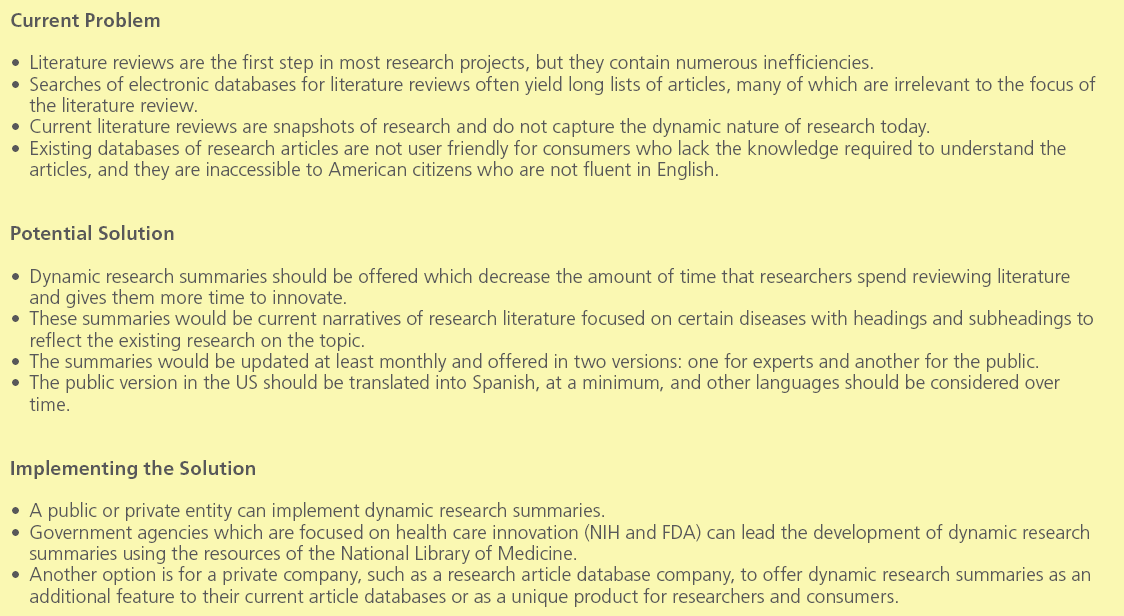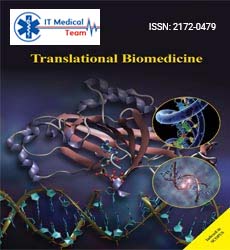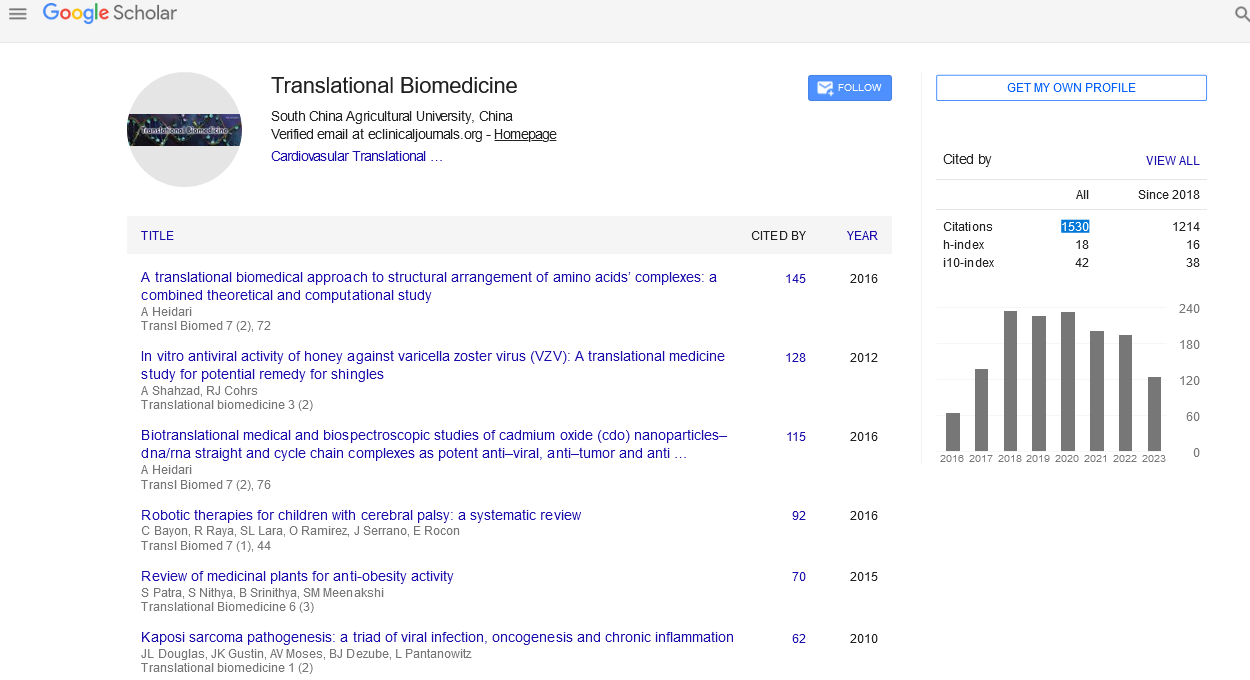The Current Problem
Any inefficiency in the health care innovation process – from idea formation to widespread adoption – can slow the speed at which patients are able to access new treatment modalities. One source of inefficiency which usually occurs at the beginning of the innovation process is the time and energy intensive search for information on a particular medical research topic. Currently, researchers are trained early in their careers to engage in a literature review to understand the state of research in a particular area.[1,2,3]
While current electronic article databases have made this process more efficient than the days when scholars roamed libraries endlessly searching for and photocopying journal articles, these databases still contain inefficiencies. A search query of a research article database (such as MEDLINE) usually returns long lists of articles, many of which are irrelevant to the search query. The articles are not grouped in any way to help the researcher understand how they are related, if at all. The most significant information is mixed with the least significant information, leaving the prioritization of this information as another task for researchers. Finally, citizens who use these databases (such as pubmed.gov) , in pursuit of information to understand research relevant to their illness or a loved one’s condition, are not able to access information in a format that is useful for them. Non-English speaking citizens are completely blocked from accessing this information in the US because it is not translated into any other language. Simply put, research article databases are not friendly to non-experts.
With an ever increasing amount of research information available on most topics, searching databases in order to review existing literature can be a burdensome, albeit educational, process. In addition, all literature reviews are limited by the time in which they take place. In this era where the number of journals are increasing steadily (on and offline) and research findings are being generated daily, new information becomes available on a regular basis which can impact a researcher’s initial literature review. Hence, the literature review, as currently conceptualized, is an outdated first step of research, and there is a great need for better, more efficient approaches to help researchers understand the current state of literature in their area of interest.
A Potential Solution
One possible alternative to the standard literature review using electronic databases is to create dynamic research summaries that adapt with creation of new knowledge (Table 1). The creation of these summaries would entail developing a template for information on any given disease and updating this template on a regular basis (i.e. monthly). Such a template could contain major headings (such as prevention, physiology, symptoms, tests, treatment, pathology, etc.) along with subheadings representative of the existing research on the disease. These dynamic summaries could contain all significant findings relevant to the topic. While grouping information by disease makes sense for most areas of biomedical and clinical research, other groupings would be more useful for areas of health services and public health research (such as quality of care research).

Table 1: Key Points.
This resource could be written in two forms: one for researchers and one for consumers. The researcher version should provide the information in an easy to read format that an undergraduate student would be able to understand. The version for consumers should be written at a level that most citizens can understand (usually an eighth grade level). Also, the consumer version should be translated into Spanish at a minimum (in the US). Given that the Hispanic population is the largest minority group in the US, making such a resource accessible to members of this group who are limited English speakers is of great importance for improving their health. [4] Other languages should also be considered for certain regions of the country. The consumer version could also offer other methods of communicating the information, such as YouTube videos or slide presentations in order to increase accessibility to those who have other limitations–such as impaired vision or limited literacy abilities.
With this new approach, researchers could access significant, relevant information much faster in any field of interest than they can currently using the existing electronic database “article list approach.” These summaries would not remove the need for more in depth analysis of individual papers, but would provide a quick assessment of the state of research on a given disease in a particular research area of interest. Researchers would also be able to easily scan other research topics relevant to the disease which might lead to new areas of interest and discovery which the researcher would not have noticed otherwise. This approach would remove a number of inefficiencies in the innovation process such as:
• Time consuming individual literature reviews that are often conducted by new and seasoned researchers.
• Searching of multiple journals regularly to locate information on a particular topic.
• Consumers having to hunt down information by contacting numerous researchers and struggling to translate medical research information.
• Junior researchers filtering through multiple irrelevant papers that do not provide significant findings for a particular topic area instead of focusing on the most important information.
• Literature reviews losing relevance because they are not updated regularly.
Removing these inefficiencies could speed up this early stage of research. Dynamic research summaries could also speed up the writing of introduction sections of research articles and background sections of grants which are usually based on current literature reviews.
In addition to providing an evolving summary of existing research, the dynamic research summaries could include lists of current research questions raised in the article discussion sections. This list could help junior researchers quickly identify potential research questions related to existing knowledge in their field and aid experienced researchers in assessing whether their current work is in line with the key questions arising from the literature.
Implementing the Solution
The responsibility for creating dynamic research summaries could rest with the US Department of Health and Human Services which currently houses most medical information of the US and information from a number of other countries in the National Library of Medicine. NIH and the FDA have a goal to enhance medical innovation; these two agencies could lead a charge to make the discovery of medical research information more efficient for researchers and consumers with dynamic research summaries.[5,6,7]
Alternatively, a private company could also aggregate research information in this manner and sell access to a database of dynamic research summaries to government, academic, and industry researchers. Similar approaches could be taken in other countries. Regardless of the entity that creates and maintains these dynamic research summaries, this approach would represent progress towards better, easier literature reviews and provide one of many catalysts to make health care innovation more efficient for researchers and make research information more accessible to consumers looking to improve their health and the health of their communities.
Acknowledgements
This publication was supported by Award Number UL- 1TR000075 from the NIH National Center for Advancing Translational Sciences (Clinical and Translational Science Institute at Children’s National in Partnership with George Washington University, https://www.ctsicn.org). Its contents are solely the responsibility of the authors and do not necessarily represent the official views of the National Center for Advancing Translational Sciences or the National Institutes of Health.
2518
References
- Yair L and Ellis TJ (2006) A Systems Approach to Conduct an Effective Literature Review in Support of Information Systems Research. Informing Science Journal 9:181-212. Available: https://inform.nu/ Articles/Vol9/V9p181-212Levy99.pdf. Accessed 12 February 2012.
- Green BN, Johnson CD, and Adams A (2006) Writing narrative literature reviews for peer-reviewed journals: Secrets of the trade. J Chiropr Med 5(3): 101-117.
- Indrayan A (2004) Elements of medical research. Indian J Med Res 119: 93-100. Available: https://www.icmr.nic.in/ijmr/2004/0301.pdf. Accessed 12 February 2012.
- Caballero AE (2011) Understanding the Hispanic/Latino patient. Am J Med 124(10 Suppl):S10-S15.
- National Institutes of Health, About NIH, Mission. Available: https:// www.nih.gov/about/mission.htm. Accessed 14 December 2011.
- US Food and Drug Administration, What does the FDA do? Available: https://www.fda.gov/AboutFDA/Transparency/Basics/ucm194877.htm. Accessed 14 December 2011.
- Voelker R (2011) FDA ponders regulation and innovation. JAMA 305(15): p. 1523-1524. Available: https://jama.ama-assn.org/ content/305/15/1523.full Accessed 12 February 2012.






